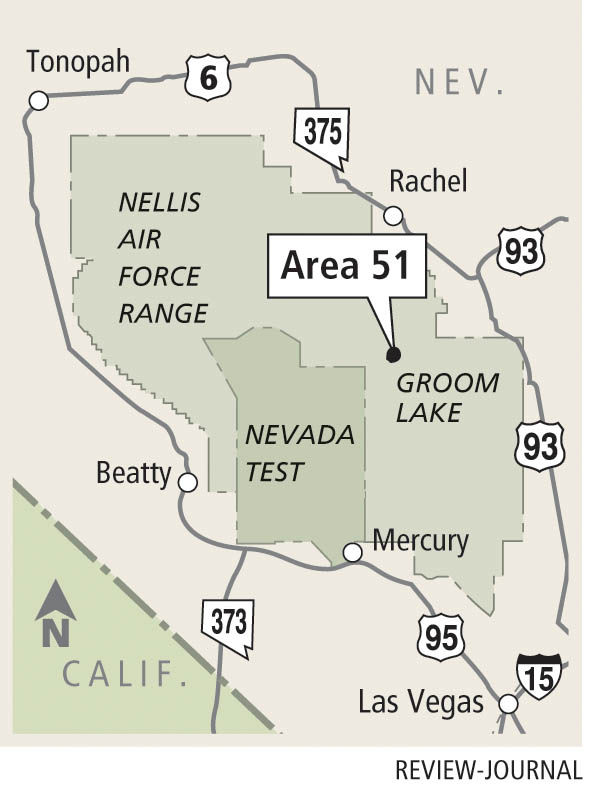Health claim roadblocks end


In 1998, the Department of Defense and the Department of Energy were keeping mum about the secret work that went on at Area 51, a widely known Air Force installation near the northeast corner of the Nevada Test Site.
That year, the U.S. Supreme Court turned away an appeal by former Area 51 workers who claimed that they were made sick and that co-workers had died from exposure to toxic fumes from stealth coatings burned in open trenches near the Groom Lake base, 90 miles north of Las Vegas. The site was used to test high-tech aircraft.
The court upheld the government’s stance that national security would be compromised if materials used at the base or even the base’s name were publicly acknowledged.
On Wednesday, another federal agency, the Department of Labor, sliced through that veil of secrecy, posting on its Web site a bulletin to its workers’ compensation staff titled: "Expansion of Nevada Test Site to include Area 51."
The bulletin opens the door for hundreds of Area 51 claimants who stand to receive $150,000 or more under the Energy Employees Occupational Illness Compensation Program.
For the past seven years, many Area 51 claimants had been told by program officials that they weren’t eligible for compensation because they had worked at the secret base and not the test site. Area 51 is a 38,400-acre rectangle of land that was transferred from the Energy Department to the Defense Department in 1999.
"The purpose of this circular is to notify all division … staff that Area 51 is part of the Nevada Test Site for the years 1958-1999," states the Aug. 5 bulletin, signed by Rachel P. Leiton, director of the Labor Department’s Division of Energy Employees Occupational Illness Compensation.
Ironically, Fred Dunham, one of the claimants whose case was under appeal and who spurred Leiton’s decision, learned late Wednesday that the Labor Department intends to deny his appeal. That, according to Labor Department spokesman Loren Smith, is because Dunham’s former employer, EG&G Special Projects, was a Department of Defense contractor, and not one of the so-called "captive contractors" for the Department of Energy at Area 51.
"Employees other than REECO and Bechtel ‘are’ covered. EG&G and Wackenhut ‘are’ included, and I’m told other contractor or subcontractor employees may be identified as (the Department of Labor) processes claims," Smith wrote in an e-mail to the Review-Journal.
"Again, the REECO and Bechtel mentioned in the (bulletin) is not an exhaustive list of covered contractors or subcontractors. EG&G Special Projects was a DOD, not DOE contractor and thus they are not covered," Smith’s e-mail stated.
Dunham, 57, who suffers from chronic obstructive pulmonary disease, says his health problems might not only be linked to inhaling dioxin-laden fumes while he worked as a security guard at Area 51. He also was on duty after the 1986 Mighty Oak nuclear weapons test "blew the doors" off a tunnel, resulting in a controlled release of radioactivity that was detected in the vicinity of where he was standing outside, about seven miles east of the tunnel.
The Mighty Oak nuclear detonation was conducted by the Department of Defense and Lawrence Livermore National Laboratory, a Department of Energy lab that was managed and operated at the time by the University of California.
"Just because you were a DOD contractor doesn’t mean you didn’t get exposed to radiation," Dunham said. "I was right there when Mighty Oak ended. What does that mean? I don’t have any rights because I’m a DOD contractor and it was a DOD event?"
After months of waiting for the Labor Department’s bulletin to be posted, Dunham said he is holding out hope that his appeal will get special consideration. He said a clerk who handles final adjudication appeals in Washington, D.C. has eight cases — including his — that have been sitting on her desk while she waits for written direction from her supervisors on how to proceed.
Dunham fears that the deck is stacked against Area 51 workers who were employed by EG&G Special Projects.
"Now all those guys who died and got sick, this is all going to be for nothing," Dunham said.
John Funk, chairman of a nonprofit Las Vegas advocacy group, Atomic Veterans and Victims of America, estimates hundreds of new claims will be filed because of Leiton’s circular, given that there have been some 2,000 crafts, trades and independent contract workers at Area 51.
Dunham said his next move will be to seek a class action lawsuit against the departments of Labor and Energy for discrimination and failing to provide equal protection under the law. He said he also will demand that the agencies include Area 51 in the Nevada Test Site’s profile, which is used to determine hazardous work sites and activities that affect workers’ health.
Contact reporter Keith Rogers at krogers@reviewjournal.com or 702-383-0308.












